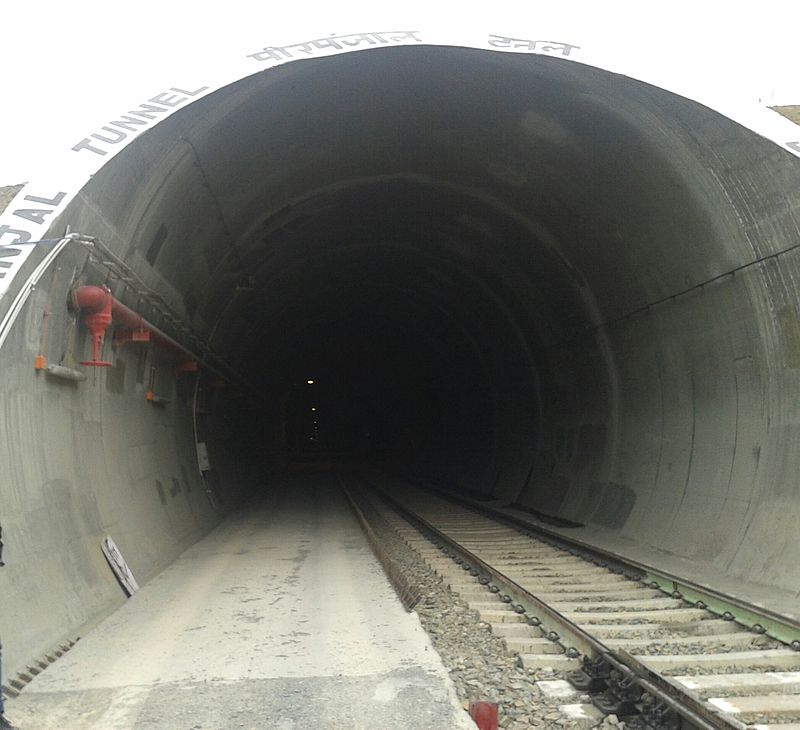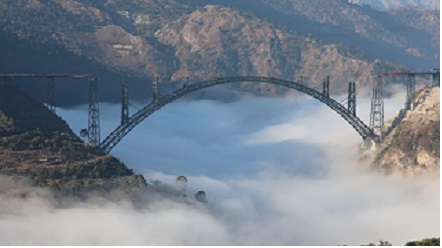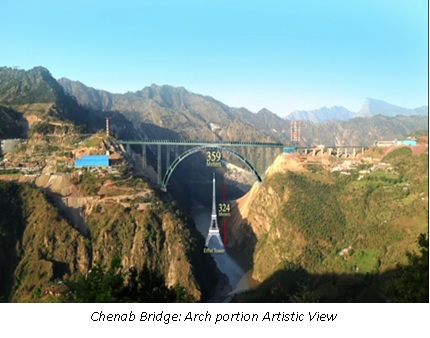According to Jehangir, “If there is a heaven on earth, it is this, this, and this.”
The poetry of God on earth can be found in Jammu and Kashmir. The area that is landlocked and has always met with connectivity problems is J&K. There is just a single road that bridges Srinagar with Jammu, and traveling on it has always been exigent. This road is full of difficulties and often encounters landslides and avalanches. Sometimes bad weather plays its role in closing up the highway for weeks. The establishment of a railway network was pivotal in many ways for this region because J&K is full of opportunities and is crucial strategically. Here, the USBRL (Udhampur Srinagar Baramulla New Railway Line Project) enters the picture, linking Kashmir, the land of beauties and opportunities, to the rest of the nation.
T-13 Tunnel
The 9.8 km long (T-13) tunnel (for the Banihal-Katra Railway link in Jammu & Kashmir) has been built and is done. There will be a quicker rail connection between the Kashmir Valley and the rest of the country in less than a year. A 111 km train route known as Tunnel “T-13” runs between two stations in the Katra Banihal sector. The New Austrian Tunneling Method (NATM), a sophisticated drill and blast method, is being used to build it. On August 29, 2022, the ends of the tunnel were finally connected by a final explosion after building on it had started in 2018. Seven rail stations will be built along this rail line. Due to the route’s complete electrification, the project will be economical and advantageous for the environment. 161 km of the 272 km of this USBRL Project is already up and functional.
T-49 Tunnel
T-49, The USBRL, the nation’s longest tunnel, is 12.758 kilometres long and is another feather in the cap of Indian Railways. Although there were many challenges during construction, Indian Railways persevered to see that their goal of creating a tunnel through such hazardous terrain was realised.
Pir Panjal Tunnel
The Pir Panjal tunnel, which is 11.20 km long and bypasses the bottleneck Jawahar tunnel, was built as the second central tunnel in the banihal to Qazigund stretch. It provides all-weather communication to Qazigund from Ramban. 
Chenab Bridge
The chenab river’s highest railway bridge in the world, located in the Kauri neighbourhood of Reasi district, was finished on August 14th. With a length of 1315 meters and a height of 359 meters,Eiffel tower is 30 mts short of this giant engineering marvel. Its lifespan is 120 years and it can withstand winds of up to 260 kmph.

- The tunnels have been designed according to sensitive seismic zone
- The structures are to be designed to be earthquake proof.
- In its design, special care has been taken of the coming floods in Kashmir valley.
Connecting Kashmir
It is anticipated that Kashmir, known as heaven on Earth, will have stronger train connections to the rest of the nation by the end of the next year. Leading Indian institutes like IIT Delhi, IIT Roorkee, DRDO, and GSI are involved in the USBRL project, along with primary organisations being Northern Railway, Konkan Railway Corporation, Indian Railway Construction Limited, and many other international organisations. Given the significance of this project, an access road up to 205 km long has also been finished, allowing for connectivity in otherwise remote and inaccessible places. The socioeconomic advancement of the local population will be an icing on the cake for nearby vicinity.
Major Benefits of USBRL Project.
- The USBRL project intends to link Kashmir with the rest of India, stimulate economic growth, build world-class infrastructure, and more. It will also aid in removing the historical isolation of the people of Kashmir.
- It will establish new industries in Kashmir, boosting the region’s economy and assisting in job creation—another key challenge—which will also be a result.
- By promoting the Kashmir valley’s tourist spots, the USBRL will improve tourism. The valley will be flooded with all-weather connectivity, which will strengthen the local economy.
- Many experts have long favoured such a route as a means of strategic and defensive elimination of insurgencies in the valley.
- This massive initiative will benefit the defence industry by making logistics transportation simple and affordable.
The USBRL project, which was intended to be straightforward and hassle-free, was designated a national project in 2002 and was expected to be finished on August 15, 2007, however owing to unforeseen circumstances, it missed many deadlines, which caused its cost to increase. According to Northern Railways, 26964 crore have been spent as of February 2022, which leaves 19% of the construction unfinished. The project is anticipated to cost more than 37,000 crore.
The then-P.M. in 1987 H.D. Dewa Gowda, a former prime minister of India, laid the foundation for the USBRL project in Udhampur. This project is the most challenging new railway line project in the Indian Subcontinent. Shear zone, highly jointed rock mass, rock problems of squeezing, and significant ingress of water are just a few of the difficulties in this railway line project.
In 1898 Maharaja Pratap Singh had a vision for a rail system in Kashmir; in 1905, a project was approved but never commissioned. In 1983, Mrs. Indira Gandhi began construction on the challenging Chenab segment, which covered Kashmir. After she laid the rail line’s foundation, there was a freeze on construction until Mr. Atal Bihari Vajpayee designated it as a national undertaking.
All-weather connectivity will be established through the USBRL project, promoting industry and other economic activity in the valley. This project will benefit locals, visitors, and the defence. When it is finished, the world will see the engineering prowess of Indian engineers who proved their mettle and made it feasible to connect heaven on earth with other regions of India.













